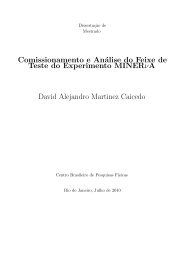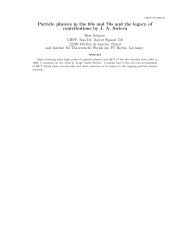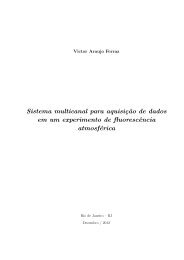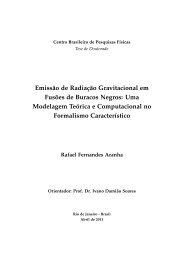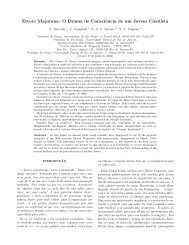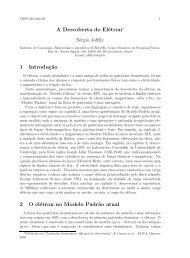Expoente de Lyapunov para um Gás de Lennard–Jones - CBPFIndex
Expoente de Lyapunov para um Gás de Lennard–Jones - CBPFIndex
Expoente de Lyapunov para um Gás de Lennard–Jones - CBPFIndex
You also want an ePaper? Increase the reach of your titles
YUMPU automatically turns print PDFs into web optimized ePapers that Google loves.
102 A.3. Equivalência entre os autovalores das matrizes Λ3×3 e Λ6×6<br />
que era o resultado que faltava <strong>para</strong> terminarmos <strong>de</strong> compor o superoperador Λ na base β<br />
completa:<br />
Λ6×6 =<br />
⎛<br />
⎝ ΛII Λ IY<br />
Λ YI Λ YY<br />
⎞<br />
⎠ =<br />
⎛<br />
⎜<br />
⎝<br />
Λ II<br />
Λ II<br />
0 − Λ II<br />
N − 1<br />
Λ II<br />
Λ II<br />
0 − Λ II<br />
0 − ΛII<br />
⎞<br />
0 − Λ II<br />
⎟<br />
⎠ (A.18)<br />
N − 1<br />
A.3 Equivalência entre os autovalores das matrizes Λ3×3 e Λ 6×6<br />
Aqui <strong>de</strong>monstraremos a afirmativa feita na seção 3.9 <strong>de</strong> que os autovalores diferentes <strong>de</strong> zero<br />
da matriz Λ6×6 , <strong>de</strong>scontando-se correções da or<strong>de</strong>m <strong>de</strong> N −1 , são os mesmo da matriz Λ3×3 .<br />
Iniciaremos escrevendo a equação secular <strong>para</strong> Λ6×6 :<br />
<br />
Det Λ6×6 − L16<br />
⎛<br />
Λ<br />
⎜<br />
= Det ⎝<br />
II − L13<br />
Λ II<br />
0 − Λ II<br />
N − 1<br />
Λ II<br />
0 − ΛII<br />
Λ II<br />
0 − Λ II<br />
0 − Λ II<br />
N − 1<br />
− L13<br />
⎞<br />
⎟<br />
⎠ = 0 (A.19)<br />
Façamos a seguinte transformação, que não altera o valor do <strong>de</strong>terminante, nas linhas 4, 5 e 6<br />
da equação anterior:<br />
linha4,5, 6 −→ linha4,5, 6 +<br />
Esta transformação resulta:<br />
1<br />
N − 1 linha1,2, 3<br />
⎛<br />
Λ<br />
⎜<br />
Det ⎝<br />
II − L13 Λ II<br />
0 − Λ II<br />
Λ II<br />
0 − L13<br />
Λ<br />
N − 1<br />
II<br />
⎞<br />
⎟<br />
⎠ = 0<br />
0 − L13<br />
Agora, <strong>um</strong>a transformação semelhante nas colunas 1, 2 e 3:<br />
coluna1,2,3 −→ coluna1,2, 3 −<br />
1<br />
N − 1 coluna4, 5,6<br />
Acarretando:<br />
⎛<br />
⎜<br />
Det ⎝ ΛII − L13 − ΛII 0 − ΛII<br />
Λ<br />
N − 1<br />
II<br />
0 − Λ II<br />
O Λ II<br />
⎞<br />
⎟<br />
⎠ = 0<br />
0 − L13<br />
Desta forma, o <strong>de</strong>terminante da equação (A.19) se escreve:<br />
Det<br />
N<br />
N − 1 ΛII −<br />
1<br />
N − 1 ΛII<br />
<br />
0 − L13 Det Λ II<br />
<br />
0 − L13<br />
= 0



